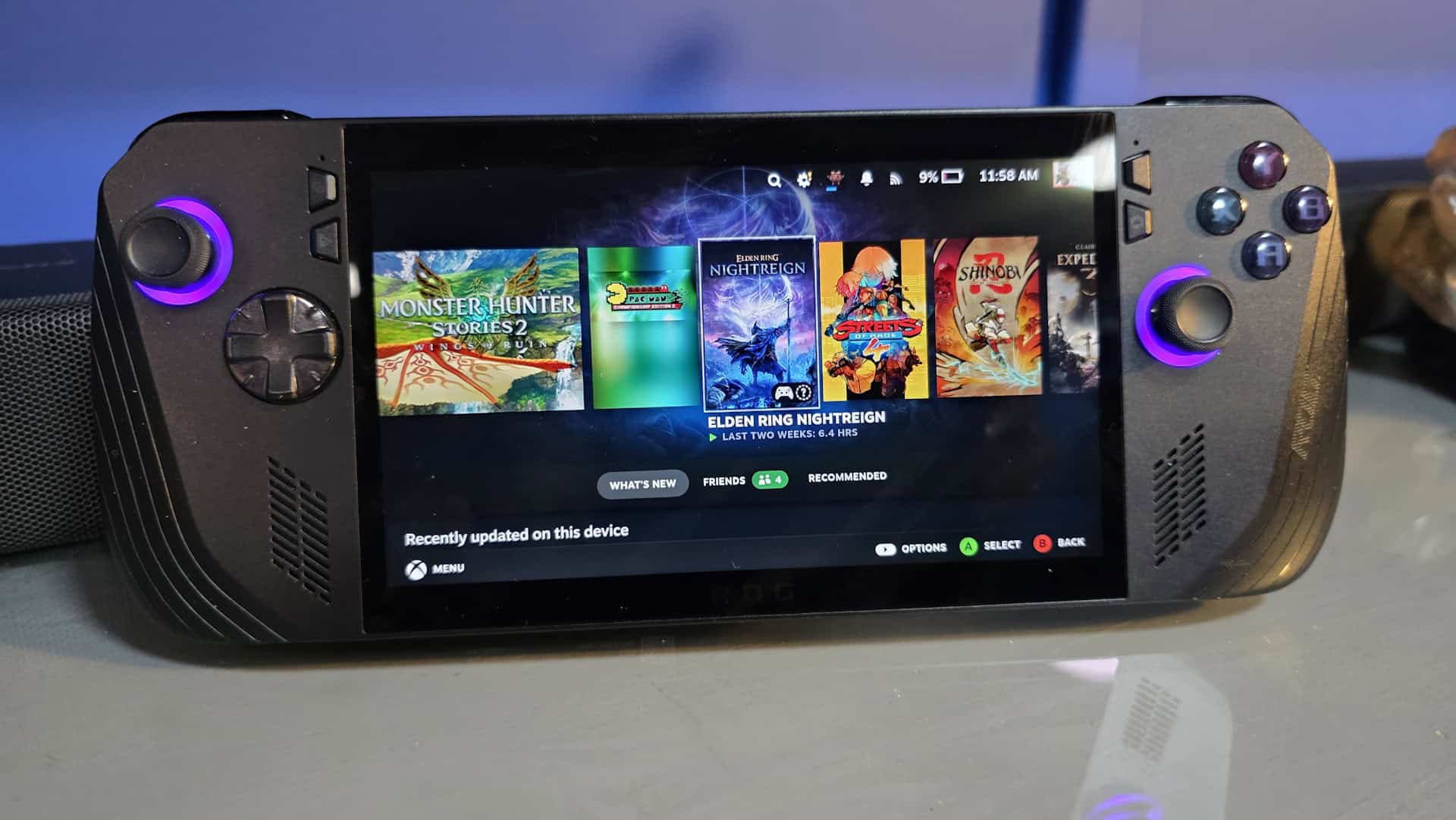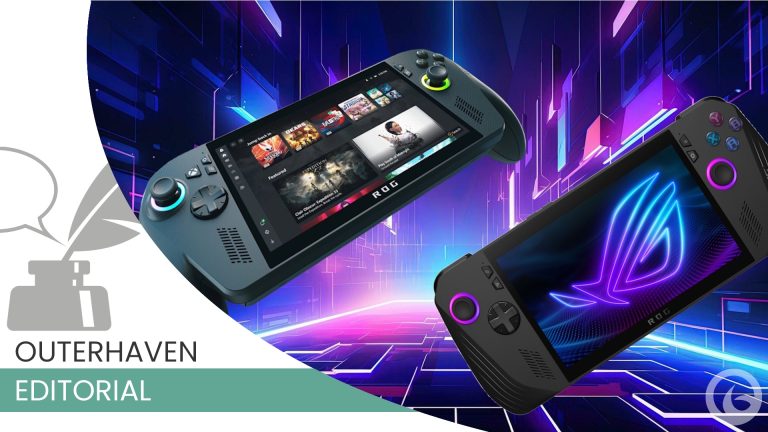When ASUS first dropped the ROG Ally, it quickly became one of the most talked-about handheld PCs on the market. Fast forward, and now we’re looking at not one but two upgraded versions. On one side, we have the ASUS ROG Ally X, and on the other, the newly revealed ROG Xbox Ally X. Both sound similar, both are powerful handhelds, but they target slightly different players.
But which one is for you? Is there a big difference? Here’s what sets them apart.
| Feature | ROG Ally X (ASUS) | ROG Xbox Ally X (Xbox-branded) |
|---|---|---|
| Processor | Ryzen Z1 Extreme (Zen 4) | Ryzen AI Z2 Extreme (Zen 5 + NPU) |
| RAM | 24 GB | 24 GB |
| Storage Options | 1 TB or 2 TB SSD | 1 TB SSD only |
| Battery | 80 Wh | 80 Wh, more efficient at idle |
| Design & Weight | Lighter, slimmer, simpler grips | Heavier, pronounced Xbox-style grips |
| Haptics | Standard HD haptics | Adds impulse triggers |
| Ports | USB‑C ×2 (PD, DP 1.4) | USB4 (DP 2.1, TB4) + USB‑C Gen 2 |
| Display | 7″ 1080p IPS, 120 Hz, VRR | Same |
| UI & Software | Armoury Crate SE | Xbox full‑screen UI + Windows under the hood |
| Estimated Price (USD) | ~$899–999 (1 TB) | Likely higher; Euro estimates ~€899 vs €599 |
Performance and Hardware
The ASUS ROG Ally X sticks with AMD’s Ryzen Z1 Extreme chip, which is based on Zen 4 architecture and powered by 12 RDNA 3 compute units. It is a proven performer, capable of handling modern PC games at solid framerates on a 7-inch 1080p 120Hz display.
The ROG Xbox Ally X, however, is running AMD’s brand-new Ryzen AI Z2 Extreme. This chip is built on Zen 5, includes an integrated NPU, and brings 16 RDNA 3.5 compute units to the table. On paper, that translates to stronger raw performance, better efficiency, and AI-driven optimizations. According to sources, that could mean around a 10 to 15 percent boost in games, along with smarter power management.
Interestingly, there’s been some testing between these two chipsets, not with the ROG Xbox Ally X, but with the MSI Claw 8+, which is using the same chipset. So far, the numbers haven’t been that impressive, but it’s still early on.

Memory and Storage
Both models come with 24GB of LPDDR5X memory, which is plenty for multitasking and heavier workloads. The difference comes down to storage. The ROG Ally X offers up to 2TB of storage, which is perfect if you plan to load up your library with Game Pass, Steam, and Epic titles. The Xbox Ally X caps out at 1TB, which is still solid, but you lose the bigger upgrade option.
Still, since you can upgrade the SSD in both units, that’s a moot point. That is, if you’re the adventurous type who wants to pop open the lid and do some surgery.
Battery Life
Battery life has always been the big question for handheld PCs, and that hasn’t changed here. Both devices pack an 80Wh battery, but the Xbox Ally X benefits from its new processor. Thanks to the Z2 Extreme’s improved efficiency, Microsoft and Asus claim it uses about a third less power at idle. That should mean slightly better endurance when streaming, browsing, or cloud gaming, even if real-world gaming times will remain close.
Still, we’ve heard that before, and even an 80Wh battery can be drained in no time based on the resolution and type of game that is played. AA, AAA games at higher resolutions will zap the power out of those devices, which is why most owners of handheld devices never leave the house without a power bank of some sort. Myself included.
Design and Ergonomics
Here’s where the biggest physical difference comes in. The ROG Ally X has a sleeker, slimmer frame that makes it more portable. It is lighter too, which some players will appreciate for long sessions.
The ROG Xbox Ally X is heavier and chunkier as it adopts Xbox-style grips and even adds impulse triggers, giving you that extra tactile feedback in shooters and racing games. The trade-off is weight, but if you want something that feels closer to an Xbox controller in your hands, this is the one.
I don’t think I’ll be trading in my ROG Ally X (unless I get a good deal for it). I do like the addition of the impulse triggers and the Xbox-style grips.
Ports and Connectivity
The ROG Ally X sticks with dual USB-C 3.2 Gen 2 ports, both capable of DisplayPort 1.4 output. It also has a microSD slot and a headphone jack.
While the Xbox Ally X pushes things further with a USB4 port that supports DisplayPort 2.1 and Thunderbolt 4, plus a second USB-C, a microSD slot, and a headphone jack. That makes it more versatile for docking, external GPUs, or faster peripherals.
Software Experience
Both devices run Windows 11, but the Xbox Ally X layers in a new Xbox full-screen UI on top. That means instant access to Game Pass, Remote Play, Cloud Gaming, and Xbox Play Anywhere titles. Armoury Crate SE is still there for performance tuning, but the overall feel is closer to using a console.
The ROG Ally X, on the other hand, relies solely on Armoury Crate SE. It is still customizable and gamer-friendly, but without the Xbox-focused enhancements.
Regardless, both devices will eventually get access to Valve’s Steam OS, and I’m already running Bazitte on my ROG Ally X, which is a clone based on Steam OS, and I don’t think I’ll ever go back to Windows. Not unless this new app that will accompany the ROG Xbox Ally will be as good as Xbox is saying it is.
Which One Should You Buy?
If you’re looking for something that’s available right now, lighter in design, and with bigger storage options, the ASUS ROG Ally X is your best bet.
On the other hand, if you don’t mind waiting until October 16, 2025, which is when the ROG Xbox Ally and ROG Xbox Ally X will be released, and like the idea of Xbox features baked directly into your handheld, then the ROG Xbox Ally X is the one to keep an eye on. It’s shaping up to be the stronger machine overall, though it will likely cost more.
The real sticking point is price. The ROG Ally X already sits on the higher end of the spectrum, around $900 for the 1TB model, with the 2TB version priced even higher. That larger model has been tough to find, and with SSDs being user-replaceable, it wouldn’t be surprising if ASUS quietly phased it out. Paying close to $1,000 for it just doesn’t make sense when upgrades are so simple.
As for the ROG Xbox Ally X, neither ASUS nor Microsoft has gone on record about pricing or release timing. Current leaks point to $899, putting it in line with the standard Ally X, but until an official announcement, that number is still up in the air.
Regardless of which direction you go, one thing is clear: handheld gaming PCs have come a long way. With ASUS and Microsoft now working side-by-side, devices like the Ally X and Xbox Ally X show that the Steam Deck, Legion Go, and MSI Claw are about to have even more competition.



